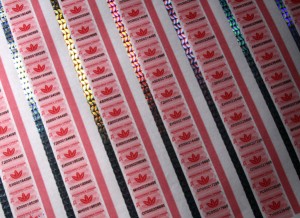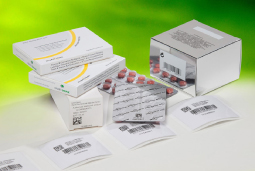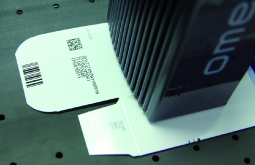High value and sensitive products are a main target for counterfeiters. We look at some of the technologies available to ensure that a product is genuine and what levels of investment in machinery and software are necessary to protect brand value
by Eric Penne, Atlantic Zeiser
 The pharmaceutical sector is a target for counterfeiters with the WHO estimating the global trade in counterfeited drugs is £75bn and growing 13% every year. The EU directive on falsified medicines could help the situation when it becomes law but how can the packaging industry step up to the challenge in this market and others? How much of a potential problem could plain cigarette packaging pose – could this end up flooding the UK with fake products?
The pharmaceutical sector is a target for counterfeiters with the WHO estimating the global trade in counterfeited drugs is £75bn and growing 13% every year. The EU directive on falsified medicines could help the situation when it becomes law but how can the packaging industry step up to the challenge in this market and others? How much of a potential problem could plain cigarette packaging pose – could this end up flooding the UK with fake products?
In terms of demand from brands and manufacturers for systems to combat counterfeiting, all industries are looking for solutions for track and trace. They need identification on products to say they are a genuine product or not. This is important for pharmaceuticals as well as cosmetics, perfume and high value products. Customer case studies include L’Oreal who are working on this.
This also follows in other sectors for several reasons – pressure of a brand’s own distribution channel and pressure for distribution to markets requires a proper track and trace for products such as perfume or high value goods. Pharmaceutical and cosmetic markets have to be able to track a product and answer technical problems. And if there are any problems for the consumer they have to be able to react quickly and on maybe a small selection of products – say removing 1 to 500 from the market.
Consumer confidence
This means track and trace does not just tackle counterfeiters but also any problems that can be rectified quickly for consumer confidence. In addition there is the Internet where you can buy from anywhere in the world – although many are aware of the risk of buying medicines from the Internet. But there are other issues. For example, countries from Western Europe sell so many million pharmaceutical products to Africa at special price. Some people buy these and try to sell them back into the west to make money. You can avoid this with tack and trace.
It is likely that the EU directive will make a difference in the pharmaceutical market and could be extended to other markets. The pharmaceutical market is followed by the cosmetic sector all the time. What happens there moves down through the industries. For example one customer has suffered in countries like the Philippines and Pakistan with products looking very similar to confuse customers so brand owners need to find way to react quickly. The approach can be used by many industries such as automotive when addressing the issue of counterfeit spare parts.
Some customers have track and trace for the whole life of the product with a unique ID to be able to do all that. Consumers do not know what they buy sometimes or where it comes from and this helps with that identification.
Tobacco industry
In the tobacco industry, with, for example, plain cigarette packaging likely to become law in the UK, there is a risk that the number of illegal products on the market will increase. With this in mind we have a big project with the cigarette industry using unique codes and security labels. This offers the ability to print codes on boxes that no-one can extract and preserves integrity. Other examples within the tobacco industry are solutions where official printers for governmental authorities and tobacco companies print tax labels for cigarette packaging.
is a risk that the number of illegal products on the market will increase. With this in mind we have a big project with the cigarette industry using unique codes and security labels. This offers the ability to print codes on boxes that no-one can extract and preserves integrity. Other examples within the tobacco industry are solutions where official printers for governmental authorities and tobacco companies print tax labels for cigarette packaging.
Another example is the perfume industry. A lot of money is spent on marketing it with film star
endorsement. To preserve that they have to have a select distribution channel. They have been fighting the grey market for many years so know that this works. This same goes for high branded goods that keep hold of the price by selling through the right channels rather than a hypermarket or supermarket where the value goes down. Brand owners can then be sure they know who they are dealing with and that they won’t sell undercover to other people.
 Selling via more specialist stores rather than supermarket and hypermarkets should be maintained, as it isimportant to hold the pricing level high. You can do that only by having a premium brand value. And premium brands will be sold in specialist stores. For example, no one will pay a premium price, for a Rolex watch as an example, when you can get it in hypermarket in the future.
Selling via more specialist stores rather than supermarket and hypermarkets should be maintained, as it isimportant to hold the pricing level high. You can do that only by having a premium brand value. And premium brands will be sold in specialist stores. For example, no one will pay a premium price, for a Rolex watch as an example, when you can get it in hypermarket in the future.
Bar codes
In order to protect branded products, there are basic systems companies should have in place. These include full solutions to customers from software generating unique codes or QR codes to print systems producing 2D Datamatrix barcodes. Then the cover information is added. This can either be done by the brand owners or by printers adding the process into their production and packaging lines; or at the end of the packaging process with connected track & trace units.
 In addition the advantage of 2D Datamatrix and QR codes is they can be placed in a small area to help the fight against counterfeiters. Companies using comprehensive software architecture can place cover information that way which that can be read on a smart phone, for example. This means the core technology is simple high quality inkjet printing which is capable to print variable data and layouts.
In addition the advantage of 2D Datamatrix and QR codes is they can be placed in a small area to help the fight against counterfeiters. Companies using comprehensive software architecture can place cover information that way which that can be read on a smart phone, for example. This means the core technology is simple high quality inkjet printing which is capable to print variable data and layouts.
Of course, this requires some investment within the supply chain, but in some areas this is being driven be regulations such as in the pharmaceutical industry where 2D Datamatrix information is printed on packaging in France, Germany in 2013, UK Belgium and all over Europe. The industry needs to have solutions to comply. There is no alternative to not having a coding and serialization solution in place by 2015, at the latest, to meet the legal EU requirements and the market needs of track & trace options. With the right equipment, printing over with security features is not too expensive. Also, QR codes can be used in marketing to get access to websites and promotions and security features can be incorporated in QR codes in the factory or sub contracted to carton board printers.
Cosmetics
Print technology is quite simple and quite straightforward to help combat counterfeiting – in the case of a cosmetic company just needing to integrate a coding module, using files and data. And, for example, carton printers can insert track and trace inline after the product is packaged and before the outer wrapping.
Playing catch up with counterfeiters is a tough job that brands and retailers have to do. The only way to fight counterfeiter is to know what is going on with your product in the market. Using track and trace you can verify quickly in the field. For example, they can have encrypted data so end-users can take an image with smart phone to see if it is a real product or a copy. Previously people had to buy product and go back to the company to check. Now there are solutions to know in real time whether these products are in the right place or also identify counterfeit products. If you can prove when in shops that the product is fake, you can call the police then and there.
